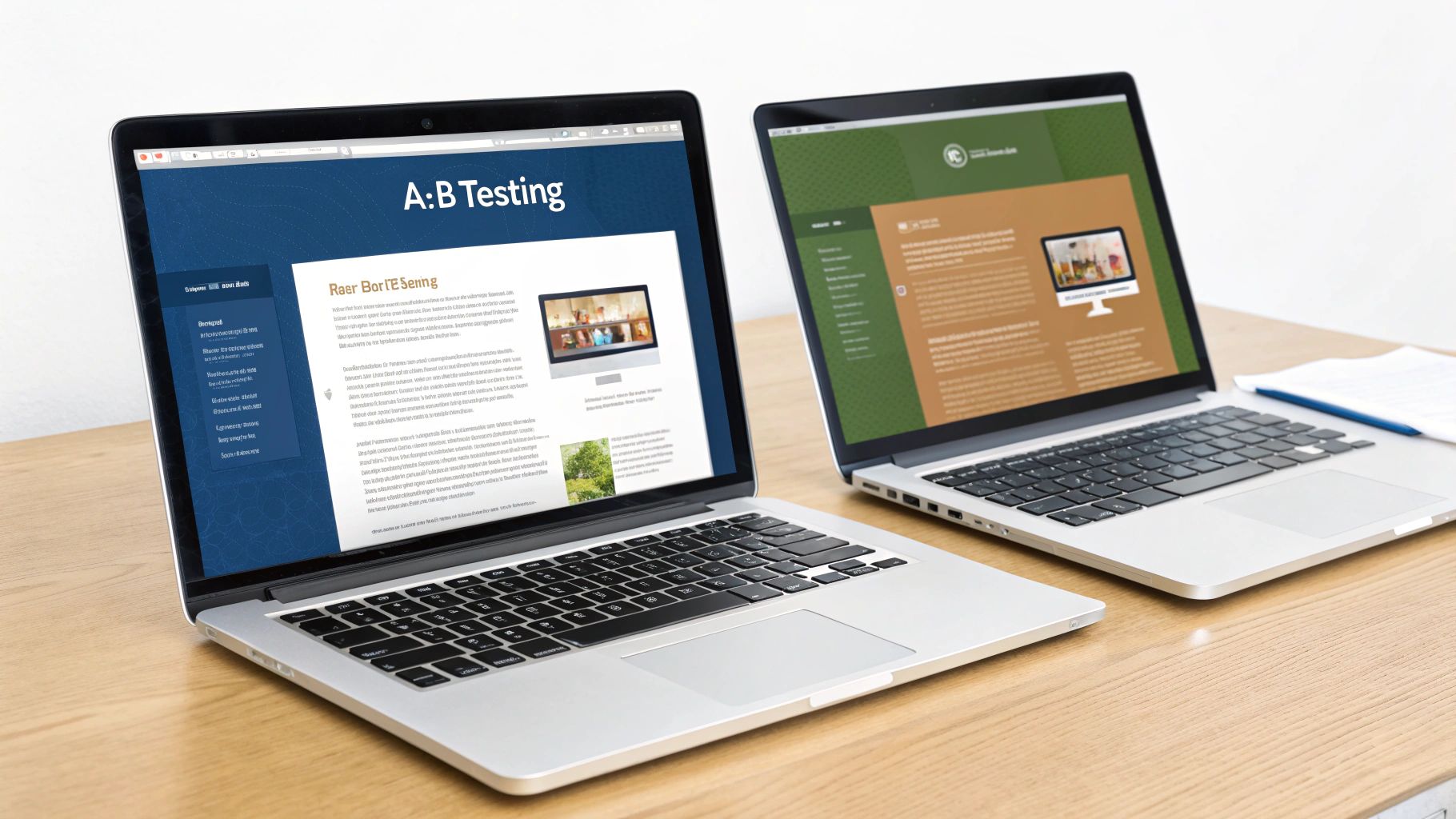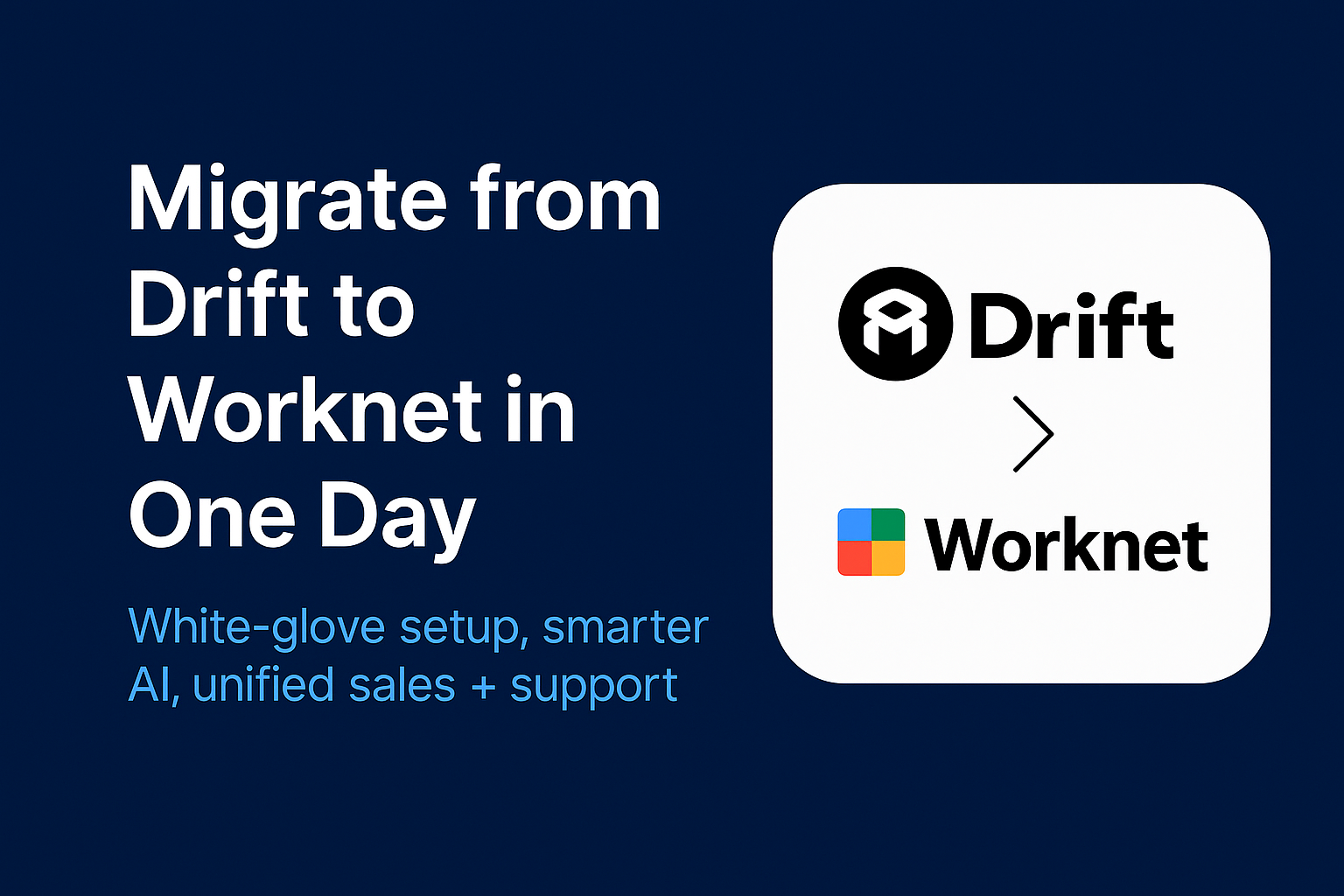10 Actionable Conversion Rate Optimization Strategies for 2025
In the competitive SaaS landscape, attracting visitors is only half the battle. The real challenge, and where significant growth originates, lies in converting that traffic into active, paying customers. This is where mastering conversion rate optimization (CRO) becomes a non-negotiable part of your growth engine. It’s the art and science of systematically improving your user's journey to increase the percentage of visitors who take a desired action, whether that's signing up for a trial, requesting a demo, or upgrading their plan.
Traditional CRO methods are powerful, but when combined with modern tools like AI-powered chat, their impact is amplified. An intelligent chat tool doesn't just answer questions; it actively guides users, personalizes experiences in real-time, and surfaces invaluable data that fuels smarter optimization decisions. These insights provide a direct line into user intent and friction points, which are critical for effective CRO. For a deeper dive into foundational techniques that can significantly boost your SaaS growth, explore additional resources on strategies to improve your website's conversion rate.
This article provides a detailed roadmap for businesses looking to transform user engagement and accelerate revenue growth through proven conversion rate optimization strategies. We'll move beyond generic advice and dive into ten specific, actionable tactics you can implement immediately. From foundational A/B testing and landing page optimization to the nuanced implementation of AI-driven personalization and enhancing trust signals, you will gain a comprehensive toolkit to build a more effective, conversion-focused user experience.
1. Implement Data-Driven A/B Testing
A/B testing, also known as split testing, is the cornerstone of data-driven marketing and one of the most fundamental conversion rate optimization strategies. It involves creating two or more versions of a single asset, like a webpage or an email, and showing them to different segments of your audience simultaneously. By measuring which version achieves a higher conversion rate, you can make informed decisions based on real user behavior rather than intuition.

The process is methodical: you identify a problem (e.g., low sign-ups), form a hypothesis (e.g., changing the call-to-action button color will increase clicks), create a variation ("B") to test against the original or control ("A"), and run the test until you achieve statistical significance.
Why It's a Foundational Strategy
A/B testing provides quantitative proof of what works and what doesn't. This eliminates guesswork and internal debates, empowering teams to incrementally improve performance. Companies like Booking.com and Amazon have built their success on a culture of continuous testing, optimizing everything from headlines to checkout flows. A famous example is Barack Obama's 2008 campaign, which increased donation sign-ups by 40% simply by testing different button and media combinations.
Actionable Tips for Implementation
To run effective A/B tests, follow a structured approach:
- Isolate Variables: Test only one element at a time (e.g., the headline or the button color, not both). This ensures you can attribute any change in performance directly to that specific element.
- Ensure Statistical Significance: Use a sample size calculator to determine how much traffic you need. Ending a test too early can lead to false conclusions based on random chance.
- Test High-Impact Pages: Focus your initial efforts on pages with high traffic or direct impact on revenue, such as your homepage, pricing page, or sign-up forms.
- Document Everything: Maintain a log of all tests, including your hypothesis, the variations, the results, and key learnings. This creates an invaluable internal knowledge base for future optimization efforts.
2. Master Landing Page Optimization
Landing page optimization is a critical discipline among conversion rate optimization strategies that focuses on refining the pages where visitors first arrive. These dedicated pages, often linked from an ad, email, or search result, are designed with a single, clear objective. The process involves systematically eliminating distractions and reducing friction to create a compelling user experience that guides visitors toward one specific conversion goal.

Unlike a general homepage that serves multiple purposes, a well-optimized landing page is a specialist. Its job is to maintain the "scent" from the initial ad or link, reassuring visitors they've come to the right place and making it as easy as possible to take the desired action, whether it's signing up for a trial, downloading a resource, or requesting a demo. This focus is a key part of modern lead generation best practices.
Why It's a Foundational Strategy
Landing page optimization directly impacts campaign ROI by ensuring the traffic you pay for has the highest possible chance of converting. By creating a one-to-one relationship between an ad and a landing page, you deliver a highly relevant and persuasive message. Pioneers like Unbounce have proven the model's effectiveness, famously showing that removing site navigation from landing pages can boost conversions significantly. Similarly, HubSpot creates unique landing pages for every content offer to maximize lead capture.
Actionable Tips for Implementation
To improve your landing pages, apply a focused, user-centric approach:
- Ensure Message Match: The headline on your landing page must directly reflect the promise made in the ad or link that brought the user there. A key component of this is learning how to write better headlines that drive clicks.
- Simplify Your Forms: Keep forms as short as possible. Only ask for the most essential information needed to qualify a lead. Each additional field you add creates friction and can decrease your conversion rate.
- Use Social Proof: Include testimonials, case study snippets, or logos of well-known customers to build trust and credibility with new visitors.
- Create a Singular Focus: Remove or minimize the main navigation menu and other distracting links. The goal is to keep the user focused on the single call-to-action (CTA) on the page.
3. Leverage Social Proof for Credibility
Social proof is a psychological phenomenon where people assume the actions of others reflect correct behavior for a given situation. As a core conversion rate optimization strategy, it involves showcasing evidence that other people are choosing, using, and valuing your product. This builds trust and reduces uncertainty for potential customers, making them more likely to convert.

By strategically placing elements like customer testimonials, user counts, partner logos, or case studies on your site, you leverage this "wisdom of the crowd" effect. When a visitor sees that peers or respected brands have already vetted your solution, it validates their own interest and lowers their perceived risk of making a purchase or signing up.
Why It's a Foundational Strategy
Social proof directly addresses a fundamental barrier to conversion: lack of trust. It provides third-party validation that your promises are credible. E-commerce giant Amazon built its empire on a robust review system, while Booking.com famously uses real-time booking data (e.g., "Booked 5 times in the last 24 hours") to create urgency and reinforce a hotel's popularity. This external validation is often more persuasive than any direct marketing message you can create.
Actionable Tips for Implementation
To effectively integrate social proof, be strategic and authentic:
- Place It Near Decision Points: Display testimonials, reviews, or user counts close to your calls-to-action, such as on pricing pages or next to a "Sign Up" button. This reinforces the decision at the critical moment.
- Be Specific and Authentic: Vague praise is less impactful. Use testimonials that include specific numbers or outcomes (e.g., "Increased our lead generation by 40%"). Whenever possible, use real names and photos of your customers.
- Use a Variety of Formats: Combine different types of social proof. Showcase logos of well-known clients, feature detailed video testimonials, display star ratings, and highlight impressive usage statistics (e.g., "Trusted by over 100,000 users").
- Keep It Fresh: Regularly update your testimonials and case studies to ensure they are recent and relevant. Outdated social proof can diminish its credibility and impact. Integrating this feedback loop can also be a key component in a strong retention plan; learn more about how to boost your customer retention on worknet.ai.
4. Perfect Your Call-to-Action (CTA)
Call-to-Action (CTA) optimization is a critical component among conversion rate optimization strategies, focusing on refining the buttons, links, and prompts that guide users toward a desired action. It involves methodically testing and improving the text, design, color, size, and placement of your CTAs to dramatically increase click-through rates and conversions. An effective CTA is clear, compelling, and stands out from the rest of the page.

The process involves identifying underperforming CTAs, hypothesizing why they are not effective (e.g., the language is too generic), and creating variations to test. For a SaaS business, this could mean changing "Sign Up" to "Start My 14-Day Free Trial" to better articulate the value and reduce friction.
Why It's a Foundational Strategy
Your CTA is the final gateway between a user's interest and their action. No matter how persuasive your copy or brilliant your design, a weak CTA can stop a conversion dead in its tracks. Companies like HubSpot and Unbounce have built their reputations on demonstrating the immense power of CTA optimization. For example, HubSpot famously increased clicks by 21% simply by changing the button text from "Submit" to the more value-driven "Get My Free Ebook." Similarly, Performable (now part of HubSpot) saw a 24% boost in conversions by switching a button color from green to a more contrasting red.
Actionable Tips for Implementation
To maximize the effectiveness of your CTAs, concentrate on clarity, value, and visibility:
- Use Action-Oriented, First-Person Language: Phrasing like "Get My Free Demo" or "Start My Trial" often outperforms "Get Your Demo" or "Start a Trial" because it makes the value proposition feel more personal and immediate.
- Create Contrast and Visibility: Your CTA button should be impossible to miss. Use a color that contrasts sharply with your site’s background and surrounding elements. Ensure it's large enough to be easily tapped on mobile devices.
- Communicate Value, Not Action: Instead of generic words like "Submit" or "Download," tell users exactly what they will get. "Get Instant Access" is far more compelling than "Click Here."
- Place CTAs Strategically: Position your primary CTA above the fold where it’s immediately visible. Also, include CTAs at natural pause points within your content and at the very end of the page to capture users when they are most engaged.
5. Prioritize Website Speed Optimization
Website speed optimization is the process of improving page load times and overall site performance, and it stands as one of the most impactful conversion rate optimization strategies. In an era of instant gratification, users have minimal patience for slow websites. Studies consistently show that even a one-second delay can drastically increase bounce rates and sink conversions, making site performance a critical factor for business success.
This strategy involves a technical audit and enhancement of both front-end and back-end elements to ensure your website responds almost instantaneously to user requests. By reducing the time it takes for content to appear, you create a seamless and frustration-free user experience that encourages visitors to stay and convert.
Why It's a Foundational Strategy
Speed is not just a technical metric; it is a direct reflection of your brand's respect for the user's time. Major companies have proven the direct correlation between speed and revenue. For example, Walmart found that for every one-second improvement in page load time, conversions increased by 2%. Similarly, Amazon calculated that a slowdown of just one second could cost it $1.6 billion in sales annually. These figures prove that optimizing for speed is a high-ROI investment.
Actionable Tips for Implementation
To significantly boost your website's speed, focus on these key technical areas:
- Optimize Images: Compress images without sacrificing quality and use modern, efficient formats like WebP. Ensure images are properly sized for their containers to avoid loading unnecessarily large files.
- Minimize HTTP Requests: Reduce the number of individual files the browser has to load. You can achieve this by combining multiple CSS and JavaScript files into single, streamlined files.
- Use a Content Delivery Network (CDN): A CDN stores cached copies of your site on servers around the world, delivering content from the location closest to the user for much faster load times.
- Enable Browser Caching: Instruct browsers to store static assets like logos, CSS, and JavaScript locally. This makes subsequent page loads significantly faster for returning visitors. To dive deeper into this crucial aspect of user experience and conversions, you can learn more about how to optimize website performance for speed and UX.
6. Use Personalization and Dynamic Content
Personalization is a powerful approach that tailors website content and user experiences based on individual visitor data. By leveraging information like location, browsing behavior, or purchase history, you can deliver dynamic content that feels uniquely relevant to each user. This is a key component in the modern suite of conversion rate optimization strategies because it shifts the focus from a one-size-fits-all model to a one-to-one conversation, making visitors feel understood and valued.
This strategy involves dynamically changing elements on a page, from product recommendations to hero images, to match the user's context and intent. Instead of showing every visitor the same generic message, you present them with content that directly addresses their needs, significantly increasing the likelihood of conversion.
Why It's a Foundational Strategy
Personalization directly boosts relevance, which is a primary driver of engagement and conversions. When content speaks to a user's specific situation, it captures their attention and builds trust. E-commerce giant Amazon famously attributes as much as 35% of its revenue to its recommendation engine. Similarly, Netflix's hyper-personalized homepage is designed to reduce choice paralysis and guide users to content they are likely to enjoy, dramatically increasing viewing time and retention.
Actionable Tips for Implementation
To effectively implement personalization, start small and build complexity over time:
- Start with Simple Segments: Begin by personalizing content based on easily accessible data. For example, show different offers to new vs. returning visitors or customize content based on the visitor's geographic location.
- Leverage Behavioral Data: Use a visitor's browsing history to display relevant product recommendations or recently viewed items. If a user has been looking at a specific category, feature it prominently on their next visit.
- Customize by Traffic Source: Create unique landing page experiences for visitors arriving from different channels (e.g., a Google ad, a social media post, or an email campaign). Align the page's headline and offer with the source message for a seamless journey.
- Respect User Privacy: Always be transparent about the data you collect and how you use it. Provide clear privacy policies and give users control over their data to build long-term trust. For a deeper look into creating tailored user journeys, explore the principles of customer experience personalization.
7. Enhance the Mobile User Experience
Mobile experience optimization is one of the most critical conversion rate optimization strategies in an era where mobile traffic frequently surpasses desktop. This goes far beyond simply having a responsive design; it involves creating a user journey specifically tailored for the smaller screens, touch-based interactions, and on-the-go context of smartphone and tablet users. A poor mobile experience creates friction, leading to high bounce rates and abandoned carts.
A seamless mobile interface directly translates to user satisfaction and higher conversions. The goal is to make every interaction, from browsing to purchasing, feel effortless and intuitive on a mobile device. By catering to the unique needs of mobile users, you remove barriers that would otherwise send potential customers to your competitors.
Why It's a Foundational Strategy
With Google's mobile-first indexing, a superior mobile experience is no longer just a nice-to-have, it's a prerequisite for both SEO success and revenue growth. Users expect fast, easy-to-navigate mobile sites. Companies that master this have seen remarkable results. For instance, e-commerce giant ASOS boosted its mobile conversion rate by 50% by redesigning its mobile checkout process to be simpler and more intuitive. This proves that a dedicated focus on the mobile journey is a direct path to increasing sales.
Actionable Tips for Implementation
To effectively optimize your mobile experience, prioritize speed and simplicity:
- Design for Touch: Use large, easily tappable buttons and form fields. Ensure there is ample space around interactive elements to prevent accidental clicks.
- Simplify Forms: Minimize the number of fields required. Leverage features like auto-fill and social logins to speed up the process for users.
- Integrate Mobile Payments: Implement one-tap payment options like Apple Pay and Google Pay. This significantly reduces the friction associated with entering credit card details on a small screen.
- Prioritize Load Speed: Optimize images, leverage browser caching, and minimize code to ensure your pages load almost instantly, even on slower mobile networks.
- Test on Real Devices: Do not rely solely on browser-based emulators. Test your website on a variety of actual iOS and Android devices to identify real-world usability issues.
8. Streamline Your Checkout Process
Checkout process optimization is one of the most critical conversion rate optimization strategies for any business selling products or services online. It focuses on streamlining the final steps of a purchase to reduce cart abandonment and increase completed transactions. This involves systematically removing friction, building trust, and making the payment process as simple and secure as possible for the user.
A lengthy or confusing checkout is a major cause of lost revenue. By simplifying this final stage, you can capture sales from users who are ready to buy but might be deterred by unnecessary steps or a lack of clarity. Amazon's patented one-click checkout is a legendary example, fundamentally changing e-commerce by making purchasing almost effortless.
Why It's a Foundational Strategy
The checkout page is the final barrier between a prospective customer and a completed sale. Any friction at this stage has a direct and immediate negative impact on your revenue. By optimizing this flow, you are targeting users with the highest purchase intent. Shopify reports that stores implementing express checkout options like Shop Pay see up to 1.8 times higher conversion rates, demonstrating the immense value of a seamless final step. This strategy provides one of the highest returns on investment because it converts visitors who have already decided to buy.
Actionable Tips for Implementation
To effectively optimize your checkout process, focus on removing obstacles and building confidence:
- Offer Guest Checkout: Forcing users to create an account is a major conversion killer. Allow a guest checkout option to expedite the process for new customers.
- Display Security Badges: Prominently feature SSL certificates, trust seals (like Norton or McAfee), and credit card logos. This visually reassures users that their payment information is secure.
- Ensure Price Transparency: Show all costs upfront, including taxes and shipping fees. Surprise charges are the leading cause of cart abandonment.
- Provide Multiple Payment Options: Cater to user preferences by including major credit cards, digital wallets (like PayPal, Apple Pay, Google Pay), and other popular methods.
- Use a Progress Indicator: A visual bar showing the steps (e.g., Shipping > Billing > Review > Complete) helps manage user expectations and reduces anxiety during the process.
9. Amplify Trust with Clear Signals
Trust signal enhancement is the strategic practice of embedding elements across your website that build credibility and reduce a visitor's perceived risk. These signals are vital conversion rate optimization strategies because they reassure potential customers that your business is legitimate, secure, and dependable. In an online environment where users are inherently cautious, especially when sharing personal information or making payments, trust is a direct driver of conversions.
This process involves more than just a security badge. It's about creating a comprehensive ecosystem of credibility, from displaying well-known payment logos to showcasing transparent customer reviews and clear contact information. Each signal works to dismantle a potential buyer's hesitation, making them feel more comfortable moving forward.
Why It's a Foundational Strategy
Trust is the currency of the internet. Without it, even the most compelling offer will fail. By proactively addressing user anxieties about security, legitimacy, and quality, you remove significant friction from the buying journey. For example, security companies like VeriSign and McAfee popularized the use of security seals, which became visual shortcuts for "this site is safe." E-commerce platforms quickly demonstrated that prominently displaying these, along with money-back guarantees, directly boosted checkout completion rates.
Actionable Tips for Implementation
To effectively enhance trust, integrate these signals at critical decision-making points:
- Display Security Badges Prominently: Place SSL certificates (e.g., from Norton or Comodo) and security seals (like McAfee Secure) on your homepage, sign-up forms, and, most importantly, your checkout pages.
- Showcase Social Proof: Use authentic customer testimonials, ideally with real names and photos. Display logos of well-known companies that use your service to leverage their brand authority.
- Be Transparent and Accessible: Include a detailed "About Us" page, a physical business address, and an easily accessible phone number or contact form. This shows you are a real, accountable organization.
- Highlight Guarantees: Clearly display your money-back guarantee, return policy, or free trial information near call-to-action buttons. This reduces the financial risk for the customer and shows confidence in your product.
10. Simplify and Optimize Forms
Forms are the final gateway to conversion, whether it's for a lead magnet, a demo request, or a purchase. Form optimization is a critical conversion rate optimization strategy focused on making this final step as seamless and frictionless as possible. It involves systematically refining the design, fields, and user experience of your forms to reduce abandonment and maximize successful submissions.
The goal is to eliminate any hesitation or difficulty a user might face. This is achieved by simplifying the process, asking only for essential information, and providing clear guidance. A well-optimized form respects the user's time and effort, directly impacting their decision to convert.
Why It's a Foundational Strategy
Every field in a form presents a potential point of friction. The more effort required, the higher the chance of abandonment. By optimizing forms, you directly address one of the highest-leverage points in the conversion funnel. For example, HubSpot famously discovered that reducing form fields from four to three increased their conversion rate by a staggering 50%. This demonstrates that even minor adjustments can yield significant returns.
Actionable Tips for Implementation
To effectively optimize your forms, focus on removing barriers and building user confidence:
- Only Ask for What You Need: Scrutinize every field. Is "Phone Number" essential for a newsletter signup? Probably not. Less is more; you can always gather more data later in the customer journey.
- Use a Single-Column Layout: Research from UX experts like Luke Wroblewski shows that single-column forms are completed faster than multi-column layouts. This linear path is easier for users to follow without their eyes jumping around the page.
- Implement Real-Time Validation: Provide immediate feedback as users fill out the form, not just after they hit "submit." A green checkmark for a valid email or a red error message for an incorrect format guides users effectively and reduces frustration.
- Leverage Progress Indicators: For multi-step forms, use progress bars to show users where they are in the process and how much is left. This manages expectations and motivates them to complete the form.
- Optimize for Mobile: Ensure your forms use appropriate mobile input types (e.g.,
type="email",type="tel") to bring up the correct keyboard, making submission on smaller devices much easier.
Top 10 CRO Strategies Comparison
Turning Insights into Action: Your Path to Higher Conversions
You’ve explored a comprehensive suite of conversion rate optimization strategies, from the foundational power of A/B testing and landing page optimization to the nuanced art of building trust and personalizing user journeys. We've dissected everything from CTA button colors and form field friction to the critical need for lightning-fast page loads and a flawless mobile experience. It's clear that successful conversion rate optimization isn't about finding a single "magic bullet" but about building a systematic, data-driven culture of continuous improvement.
The true takeaway is that each strategy, while powerful on its own, achieves its maximum potential when integrated into a cohesive system. Enhancing your trust signals, for example, makes your optimized CTAs more compelling. A faster website, in turn, ensures users actually stick around to see your personalized content and frictionless checkout process. This interconnectedness is the engine of sustainable growth.
Synthesizing Your Strategy: From Theory to Reality
Moving from reading about these tactics to implementing them can feel daunting. The key is to avoid analysis paralysis and embrace an iterative mindset. You don't need to overhaul your entire digital presence overnight. Instead, focus on creating a repeatable process that turns insights into action.
Here are your actionable next steps to get started:
- Establish a Baseline: Before you change anything, you must know where you stand. Use analytics tools to document your current conversion rates for key funnels, like demo requests, trial sign-ups, or newsletter subscriptions. This baseline is your benchmark for success.
- Identify High-Impact Opportunities: Analyze your data to find the biggest leaks in your funnel. Is there a massive drop-off on a specific landing page? Are users abandoning your sign-up form? These high-friction points are your prime candidates for initial testing.
- Formulate a Hypothesis: Don't just make changes randomly. Create a clear, testable hypothesis for every experiment. For example: "By replacing the generic 'Submit' button with a benefit-driven CTA like 'Get My Free Demo,' we will increase form submissions by 15% because it clarifies the value for the user."
- Test, Measure, and Iterate: Run your A/B test until you reach statistical significance. Whether your hypothesis is proven or disproven, you gain a valuable insight. Document the learning and use it to inform your next hypothesis. This is the core loop of all effective CRO.
The Overarching Principle: A Relentless Focus on User Experience
Ultimately, every one of these conversion rate optimization strategies serves a single, higher purpose: to create a better, more intuitive, and more valuable experience for your user. When you reduce friction, build trust, and deliver relevant content, you aren't just manipulating metrics. You are fundamentally aligning your business goals with your customers' needs.
This user-centric approach is where modern tools like AI-powered chat become a game-changer for SaaS businesses. They allow you to proactively apply these principles in real-time, guiding a user through a complex pricing page, answering a critical question during a trial, or offering help just before they abandon a cart. By weaving a conversational layer across the customer journey, you transform static web pages into dynamic, responsive experiences that build relationships and drive conversions. Mastering this ongoing cycle of testing, learning, and refining is your definitive path to unlocking sustained growth and outperforming the competition.
Ready to supercharge your user engagement and turn more visitors into customers? Discover how Worknet.ai Inc can help you implement these conversion rate optimization strategies with intelligent, proactive AI chat. Visit Worknet.ai Inc to see how our platform can guide users through your funnel, answer questions in real-time, and capture leads you might otherwise miss.
FAQs
.png)
Lorem ipsum dolor sit amet, consectetur adipiscing elit. Suspendisse varius enim in eros elementum tristique. Duis cursus, mi quis viverra ornare, eros dolor interdum nulla, ut commodo diam libero vitae erat. Aenean faucibus nibh et justo cursus id rutrum lorem imperdiet. Nunc ut sem vitae risus tristique posuere.
Lorem ipsum dolor sit amet, consectetur adipiscing elit. Suspendisse varius enim in eros elementum tristique. Duis cursus, mi quis viverra ornare, eros dolor interdum nulla, ut commodo diam libero vitae erat. Aenean faucibus nibh et justo cursus id rutrum lorem imperdiet. Nunc ut sem vitae risus tristique posuere.
Lorem ipsum dolor sit amet, consectetur adipiscing elit. Suspendisse varius enim in eros elementum tristique. Duis cursus, mi quis viverra ornare, eros dolor interdum nulla, ut commodo diam libero vitae erat. Aenean faucibus nibh et justo cursus id rutrum lorem imperdiet. Nunc ut sem vitae risus tristique posuere.
Lorem ipsum dolor sit amet, consectetur adipiscing elit. Suspendisse varius enim in eros elementum tristique. Duis cursus, mi quis viverra ornare, eros dolor interdum nulla, ut commodo diam libero vitae erat. Aenean faucibus nibh et justo cursus id rutrum lorem imperdiet. Nunc ut sem vitae risus tristique posuere.
Lorem ipsum dolor sit amet, consectetur adipiscing elit. Suspendisse varius enim in eros elementum tristique. Duis cursus, mi quis viverra ornare, eros dolor interdum nulla, ut commodo diam libero vitae erat. Aenean faucibus nibh et justo cursus id rutrum lorem imperdiet. Nunc ut sem vitae risus tristique posuere.
Lorem ipsum dolor sit amet, consectetur adipiscing elit. Suspendisse varius enim in eros elementum tristique. Duis cursus, mi quis viverra ornare, eros dolor interdum nulla, ut commodo diam libero vitae erat. Aenean faucibus nibh et justo cursus id rutrum lorem imperdiet. Nunc ut sem vitae risus tristique posuere.
Lorem ipsum dolor sit amet, consectetur adipiscing elit. Suspendisse varius enim in eros elementum tristique. Duis cursus, mi quis viverra ornare, eros dolor interdum nulla, ut commodo diam libero vitae erat. Aenean faucibus nibh et justo cursus id rutrum lorem imperdiet. Nunc ut sem vitae risus tristique posuere.
Lorem ipsum dolor sit amet, consectetur adipiscing elit. Suspendisse varius enim in eros elementum tristique. Duis cursus, mi quis viverra ornare, eros dolor interdum nulla, ut commodo diam libero vitae erat. Aenean faucibus nibh et justo cursus id rutrum lorem imperdiet. Nunc ut sem vitae risus tristique posuere.
Lorem ipsum dolor sit amet, consectetur adipiscing elit. Suspendisse varius enim in eros elementum tristique. Duis cursus, mi quis viverra ornare, eros dolor interdum nulla, ut commodo diam libero vitae erat. Aenean faucibus nibh et justo cursus id rutrum lorem imperdiet. Nunc ut sem vitae risus tristique posuere.
Lorem ipsum dolor sit amet, consectetur adipiscing elit. Suspendisse varius enim in eros elementum tristique. Duis cursus, mi quis viverra ornare, eros dolor interdum nulla, ut commodo diam libero vitae erat. Aenean faucibus nibh et justo cursus id rutrum lorem imperdiet. Nunc ut sem vitae risus tristique posuere.

.svg)


.webp)
.webp)
.webp)





